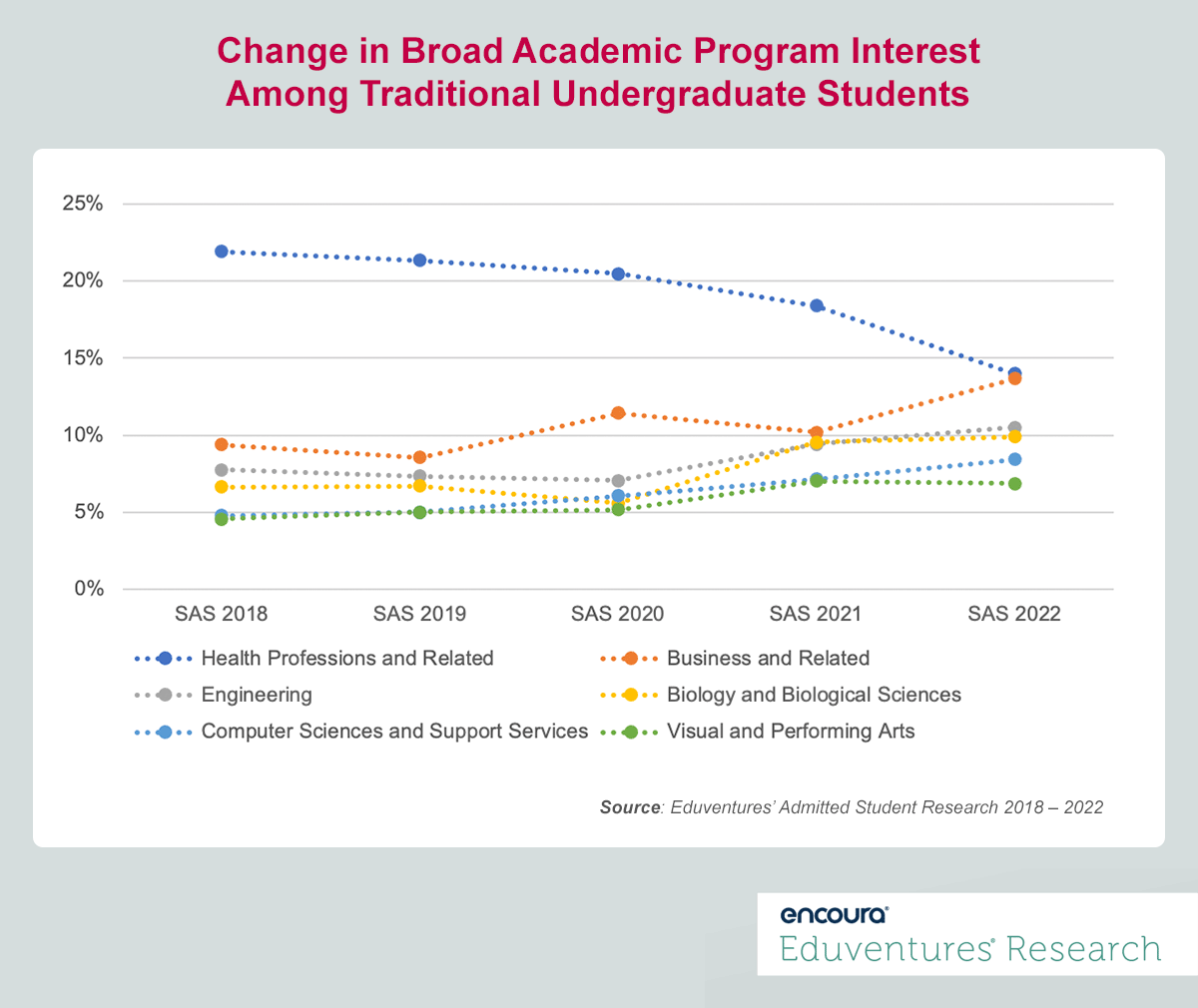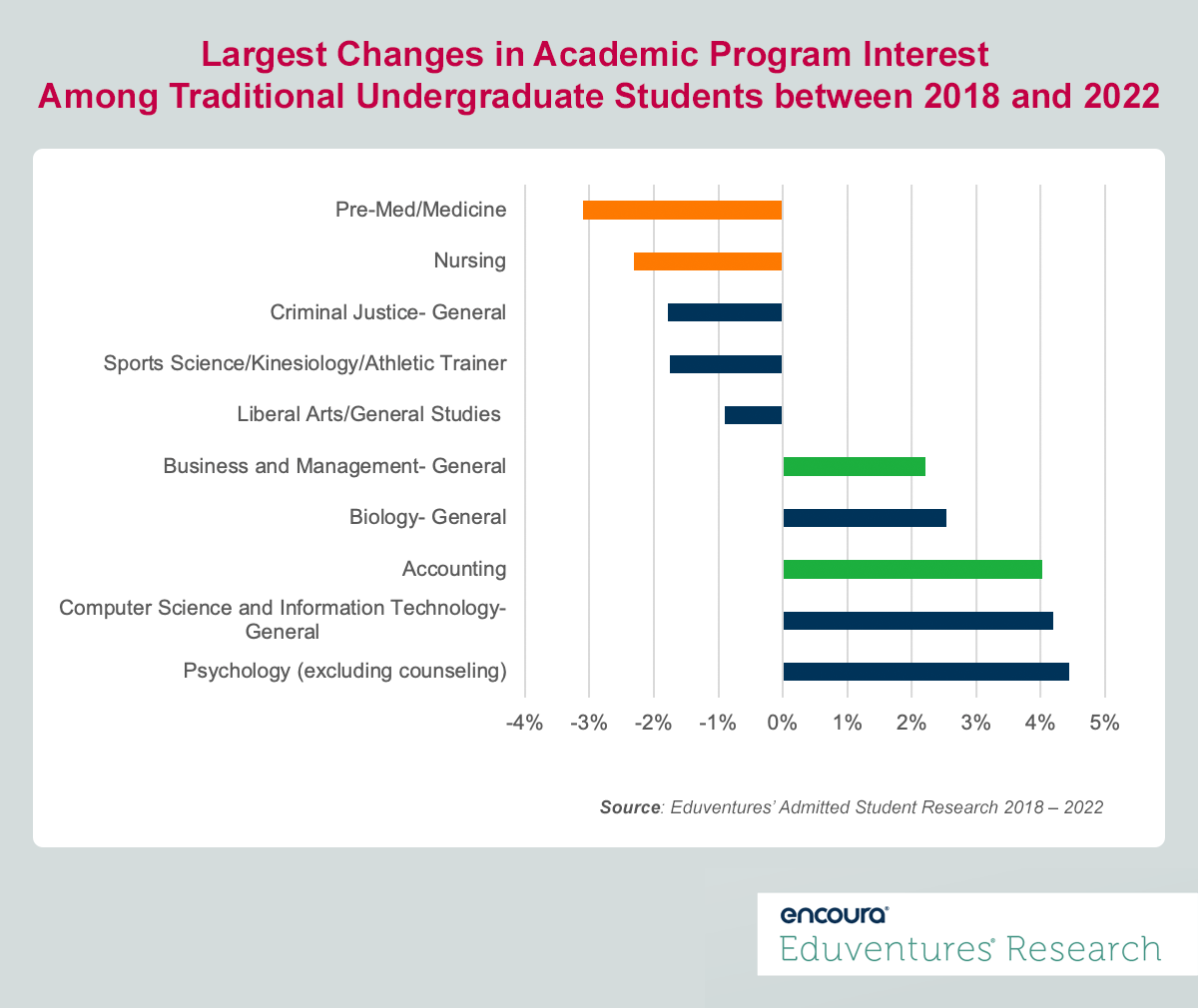The predicted success of academic programs is often based on a combination of projected labor demand and historic student demand.
Generally, this seems true. The nursing field, for instance, has offered a strong job outlook and has enjoyed long-standing popularity. But student demand can also be fickle.
Eduventures’ most recent Admitted Student Research™ shows that the nursing field—which is about to experience a tremendous labor shortage—is facing an unanticipated headwind: shifting public perceptions about what constitutes a desirable career. What do we know, and which other fields are also affected?
The life-altering, once-in-a-lifetime COVID-19 pandemic will leave its mark for years to come. Higher education continues to experience this impact, from declining enrollments to significant shifts in Student Mindsets™. One area that is strongly linked to both factors is academic program interest.
Figure 1 shows how student interest in the six most popular programmatic areas of 2022 has changed over the past five years.
Figure 1
Figure 1 shows that health-care-related programs have long dominated the list of most popular academic programs among traditional undergraduate students, but the gap between these and other programs started to close in the early months of the pandemic. In 2022, while health-care-related programs remain on top, they now share that position with business programs for the first time since Eduventures started collecting national admitted student data.
While health care programs are on a downward trend, most of the 2022 top five program areas enjoyed growing popularity throughout the pandemic. Business, engineering, biology, computer sciences, and visual and performing arts all grew in student interest compared to pre-pandemic times. Why these programs?
First, some of this can be attributed to changing student populations. The pandemic brought declining enrollment rates for first-generation and low-income students: students who disproportionately have an Experiential Interest™ Mindset. And guess what other type of student disproportionally falls into this Mindset? Those interested in studying nursing.
Second, shifting public perceptions about what constitutes a worthwhile career may also have an impact. Healthcare occupations, initially lauded as heroic in the early days of the pandemic, became quickly tainted by burnout and health risks and dropped in desirability. Is it possible that students who would otherwise be interested in this field are now opting for science-heavy classwork in less risky programs such as biology or engineering? This seems plausible.
Third, many businesses have successfully adjusted to remote work with little disruption to their operations. Meanwhile employment rates in these industries rose significantly. Did the perceived pandemic-proof job stability and the flexibility of remote work increase student interest in business and computer science related programs? This seems likely.
But these are high-level occupational areas. How do these trends translate to specific majors? Figure 2 shows the largest changes in student interest in specific academic programs between 2018 and 2022.
Figure 2
Figure 2 shows that, indeed, the decline in health-care-related programs is driven by a steep drop in interest in medicine and nursing—the health care occupations that were most negatively affected during the pandemic. If the drop in nursing interest can be at least partially explained by the Mindsets of its population, then medicine/pre-med should be on the rise given the growing number of Grad School Bound™ students who would be interested in this path. But this is not the case.
Also on a downward path is criminal justice. This field has been struggling to attract students for several years, but recent incidents of police brutality and misconduct may have helped propel this field to the third-fastest declining area of interest among traditional students.
On the flipside, a growing focus on mental health may have led to an increase in students who are interested in psychology as a field of study. Likewise, computer science and information technology, accounting, and other business-related programs lend themselves to occupations with the flexibility of remote work.
What does this all mean? The data shows us that student interest in academic programs does not always follow labor demand trends but is often influenced by shifts in the make-up of the underlying college-going population and public perceptions of the desirability of related career paths. In normal times, these perceptions can be relatively stable over long periods of time, but major events like a pandemic can disrupt established patterns more quickly.
The decline in interest in nursing and medical careers may not feel like a crisis to institutions that can turn away qualified applicants. But with a projected worsening of the nursing and medical provider shortage on the horizon, the current level of disinterest in these fields among students should be of concern. On the other hand, the sudden interest in accounting programs may be a relief to institutions that have been worried about declining conferrals in this program.
How should institutions read these trends?
The Bottom Line
While institutions should keep a finger on the pulse of public opinion, sudden changes in student interest don’t mean it is time to panic or rejoice. Rather, it is time to adjust your sails so you can ride out the storm and stay on track with your institution’s goals. Here are three things to consider:
- Your overall enrollment goals: Declining interest in academic programs is one of many factors that impacts overall enrollment numbers, albeit an important one. How do you bring back the students who left the college pipeline? If the students you are recruiting now are losing interest in your bread-and-butter programs, can you make up this loss with gains in other areas?
- Your program portfolio alignment: Do you have programs that are growing in student interest and are able to absorb a decline in student interest in other programs? Are you offering the right mix and number of programs, or is it time to reinvest?
- The way you frame your existing programs: Before you decide on these more drastic steps, consider this: How do you position your existing programs to prospective students and families? Can you reframe the messaging to counter potential misconceptions, make them more desirable for the students in your pipeline, and provide proof points to show that your graduates are successful and happy in their chosen fields?
Eduventures’ forthcoming Admitted Student Research Trend Report examines other shifts in student behavior that will help you understand the new enrollment environment that has already arrived on your doorstep.
Never Miss Your Wake-Up Call
Learn more about our team of expert research analysts here.
Eduventures Senior Analyst at Encoura
Contact
This recruitment cycle challenged the creativity of enrollment teams as they were forced to recreate the entire enrollment experience online. The challenge for this spring will be getting proximate to admitted students by replicating new-found practices to increase yield through the summer’s extended enrollment cycle.
By participating in the Eduventures Admitted Student Research, your office will gain actionable insights on:
- Nationwide benchmarks for yield outcomes
- Changes in the decision-making behaviors of incoming freshmen that impact recruiting
- Gaps between how your institution was perceived and your actual institution identity
- Regional and national competitive shifts in the wake of the post-COVID-19 environment
- Competitiveness of your updated financial aid model
Thursday, November 3, 2022 at 2pm ET/ 1pm CT
Institutional responses to COVID-19 have dominated conversations about higher education technology. Commentators have speculated about how the move to remote learning will affect how institutions rethink the technology they use to support teaching and learning. Yet, many of these discussions have focused on short-term changes in decision-making and overlooked how the pandemic fits within wider and longer trends.


